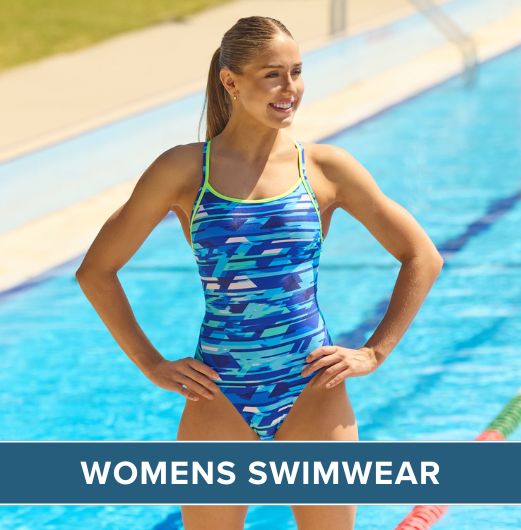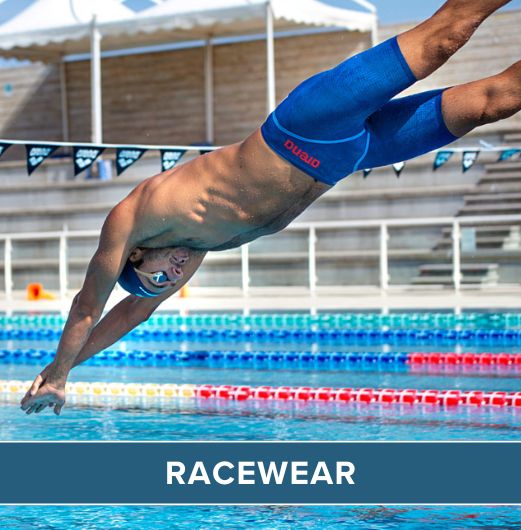For all strokes, the starts are incredibly important. Butterfly, breaststroke and front crawl can all be started on the block when racing.
There are 2 types of starts commonly used:
- Grab start
- Track start
Both starts are equal – one is not better than the other and is totally down to preference but both can be super fast when practised well.
With whichever start you use remember the starter won’t start any race until every competitor is ready to begin and still on the block. Observers underestimate how important this is, but you can get disqualified for moving on the block, falling in before the start or if you are incredibly slow at getting ready.
The Grab start
The better your starting position the better your dive so key points of the starting position are:
- Tuck the head as close to the knees as possible
- Lift the hips as high as possible without pushing them back
- Curl the toes over the edge of the block for extra grip
- Bend the knees slightly
- The arms should be straight down towards your toes and gripping the block
When the starter begins the race you want to aim to leave the block with as much force as possible. Throw your arms forward, lift your head up slightly and the rest of your body should follow your head.
As soon as your feet leave the block, push your hips up and tuck your head in so your body is in perfect streamline for entering the water.
When entering the water imagine you are entering through a ring, trying to make the smallest amount of splash possible. If you make a big splash it means you aren’t entering the water in total streamline and your legs are not completely in line with your body.
When you have entered the water, begin your leg kick dependant on the stroke. You’re allowed to travel up to 15 metres underwater from a dive or turn so make the most of it and try to travel as far as possible underwater whilst maintaining your speed.
A common mistake which can really slow this start down is by lifting the toes off the block after the start sound and almost rocking before leaving the block. When using the grab start, aim to push forward and out without lifting the toes as this can save you a few fractions of a second (but as we know in any race every split second counts!)
Track start
The track start needs a good starting position on the block to give you a great dive. Focus on:
- Having your leading leg at the front of the block with toes curling over the edge
- The back leg should be positioned about a foot length back from the front foot
- Bend the knees slightly and grab the block with both hands, approximately shoulder width apart
- Tuck the head down
The same sequence follows as the grab start – take off with as much force possible and enter the water with the best streamline position you can.
This type of start also has a common error – not bringing both legs together in time for entry into the water. If this is one of your mistakes then you will find your speed slows dramatically and you won’t straight, heading at different angles each time you enter. Try to correct this by gently bringing the legs together before entry.
Backstroke Starts
Backstroke is the only stroke out of the four that is begun in the water.
To start backstroke: grab the block with both hands about shoulder width apart. Place both feet on the wall about shoulder width apart again and some people prefer to have one foot higher than the other. Your feet should be just below the surface of the water and allow your body to be in a slightly curled position. Tuck your head down and wait for the starter’s signal. Again the start won’t start the race until all swimmers are ready and in a still position.
A common mistake with the body position is not locking the feet on the wall in a sturdy position and slipping down the wall. Ensure you get your feet into a position that is comfortable and sturdy so you don’t have this mistake.
As soon after the signal as possible, throw the body backwards over the water by pushing your arms back away from the block and throwing your head back. Ideally, you want the swimmer’s back to be arched during the airborne phase so your hands touch the water whilst the body is still above the water’s surface.
Most swimmers begin with a butterfly kick under the water for added power and speed then break into normal backstroke leg kick when they are ready to surface. Swimmers with a great kick tend to find it much faster to swim fully under the water than on the surface so for those of you who are quicker underwater, make the most of it and head right up to that 15 metre mark!
 Free Tracked UK Delivery
Free Tracked UK Delivery Hassle Free Returns
Hassle Free Returns Next Working Day OPTION
Next Working Day OPTION Found It Cheaper?
Found It Cheaper?














